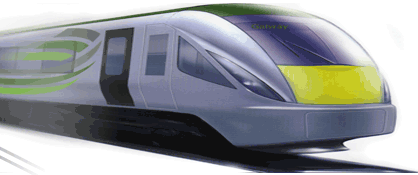West=On=Track -
News
Strategy Outlined in
Minister Ó'Cuív's Statement
7th July
2003
A Strategy for Towns on Radial
Routes in the West
Rationale
The seven-county Western Region is dominated by an urban
structure of small market towns. Clearly, while there is a
need to target gateways and hubs for investment and as
centres of knowledge, this approach on its own has limited
applicability for the predominantly rural region. It will
not ensure the stabilisation and growth of population and
rural regeneration or drive demand for transport
infrastructure investment such as the development of Knock
airport or the Western Rail Corridor.
The need for an emphasis on smaller towns as part of the
strategic development of the region has been consistently
pointed out in WDC reports. In its submission to the
National Spatial Strategy, the WDC argued that some western
towns (with populations in excess of 1,500) could be targets
for the decentralisation of government services so that they
become focal points for the creation of critical mass of
economic and social development to underpin development of
the surrounding region.
The National Spatial Strategy reiterated the government
commitment to balanced regional development, including the
development of towns outside gateways and hubs and rural
regeneration.
There are many towns well-positioned along the radial and
cross-radial routes in the West - both road and rail,
including the Western Rail Corridor - and with access to
international airports such as Knock and Shannon. The WDC
will examine strategies to build on the strengths of such
towns, most of which are located in Clar areas. They could
become the focal points for small and medium-sized overseas
firms. Indeed, along with others throughout the region, many
already have strong, well-rooted and successful indigenous
SME firms.
Developing such towns necessitates county strategies that
build on their infrastructural strengths. It is useful to
draw on the Cork experience in this context, although
obviously significantly different in scale and demographics
from the West. In the Cork Area Strategic Plan 2001-2020,
one of the key themes is a redirection of development to
corridors that can be efficiently served by public
transport, especially rail, on the basis that this will
contribute to a more sustainable future pattern of
development in the area. In order to facilitate this
reorientation of growth, significant investment in the local
rail network was proposed and is being implemented.
The Government commitment to decentralisation of
government departments and state bodies provides an
opportunity for the WDC to facilitate the strategic
positioning of the Western towns as attractive locations for
decentralisation. However, in an environment where towns are
inevitably competing for selection with others outside the
region, it is essential that there be a coherent and
well-coordinated approach to doing this.
A central element of such towns' attractiveness for
decentralisation will be access (from Dublin especially),
and the ease with which workers can commute to work locally
within the region. By the same token, the presence of a
substantial concentration of workers in towns along existing
rail routes (even if not currently operational) could
substantially enhance their viability as commuter routes.
This could have a significant impact on the feasibility of
the Western Rail Corridor. Minister for Transport Seamus
Brennan TD has already announced that he is "committed to
supporting the development of a realistic and viable plan
for the Western Rail Corridor".
Project Objective
The Western Development Commission will facilitate the
development of a strategy to position towns in the Western
Region as attractive locations for investment and for the
decentralisation of government departments and state
bodies.
This will involve
- the WDC working with regional and local authorities
to develop a Western Region strategy for investment and
employment, and decentralisation, based on clear and
agreed principles;
- the development of a typology which attempts to match
the facilities available in towns in the region to
industrial and commercial development needs and to the
requirements of government departments and state
bodies.
Project Elements
1. WDC consults with regional and local authorities
(regional and county managers) to clarify their position in
regard to the competitive positioning of towns in their
region for both investment and employment growth and
decentralisation. This includes identifying the steps which
need to be taken to strengthen the competitive position of
such towns in consultation with local authorities e.g.
amendments to county plans, site provision, upgrading of
access infrastructure. WDC secures their agreement to work
on a regional strategy, based on named principles, to
attract government departments/state agencies to locations
in the Western Region.
2. WDC develops typology of towns in the region based on
population data, transport, energy and telecommunications
infrastructure, and the outcome of ongoing WDC analysis of
the economic functioning of towns in the region. WDC works
with local authorities to identify strategic linkages
necessary e.g linkages between towns, roads investment,
Western Rail Corridor.
Outcome
Regional strategy based on above for submission to
Minister for Community, Rural and Gaeltacht Affairs.
|
